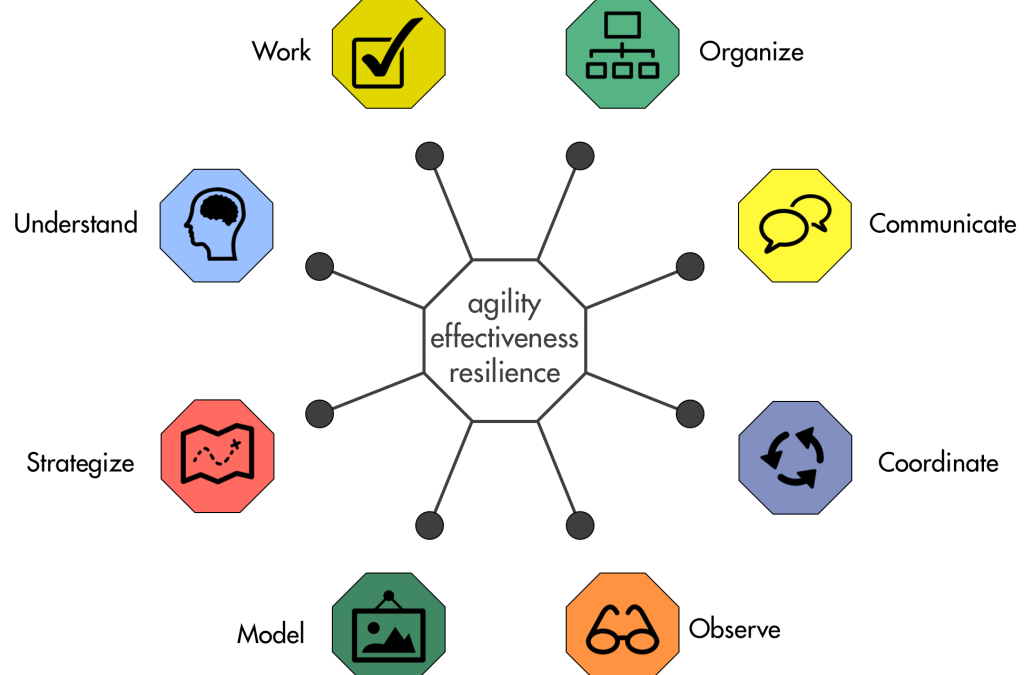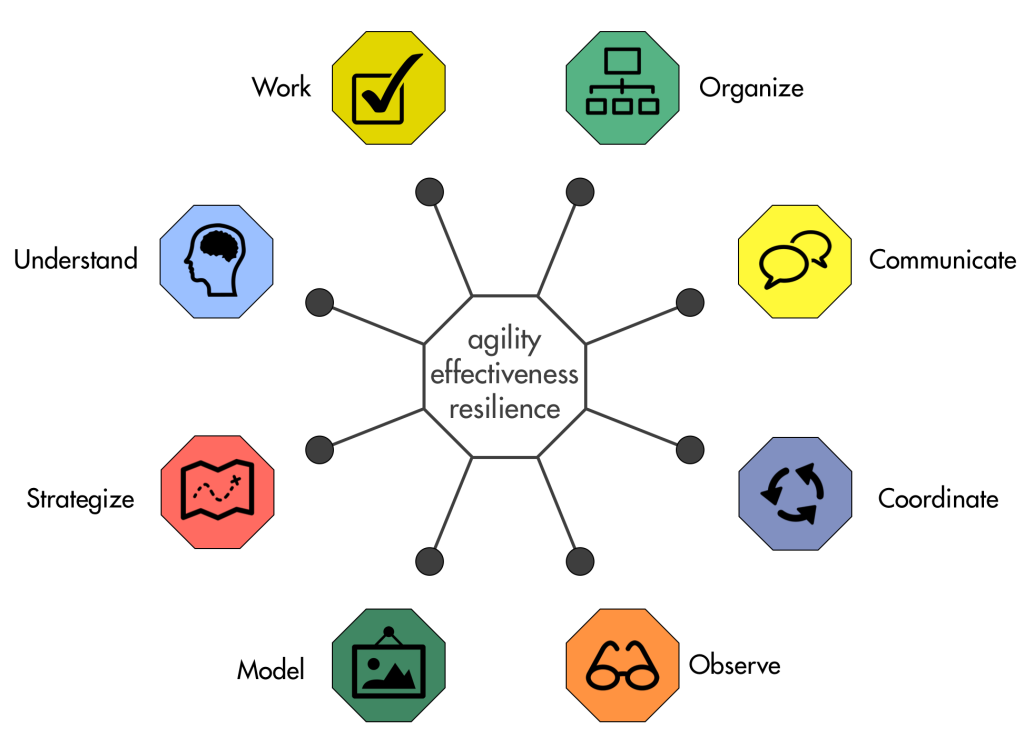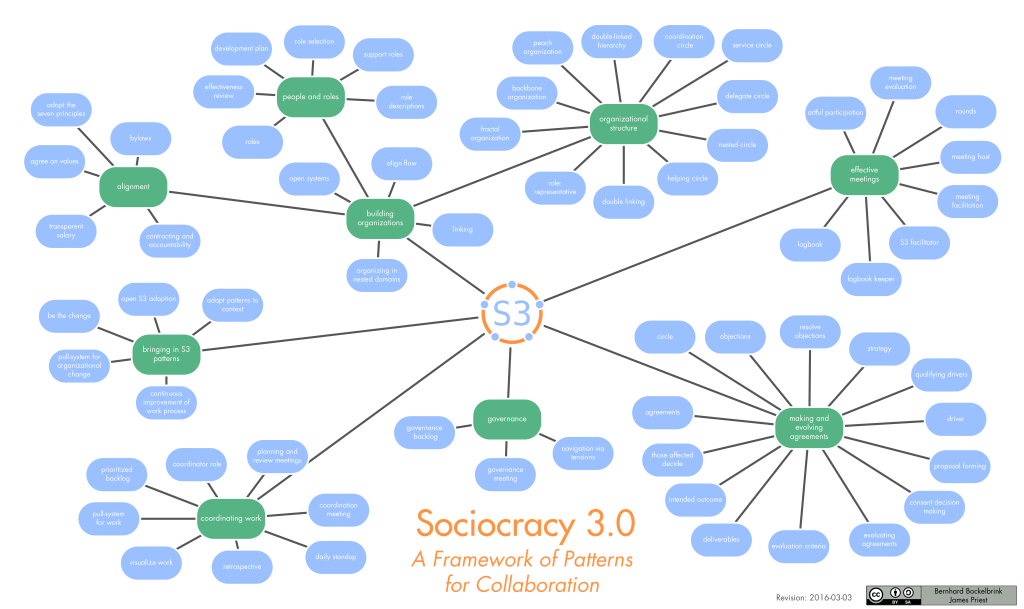A few days ago I had a workshop with Alexander Tornow and Volker Schad, where Alexander presented Stafford Beer’s Viable System Model (VSM), I explained S3, and then we discussed how S3’s patterns relate to systems 1-5 of VMS.
I don’t claim to understand VSM in its entirety, and I must admit I remain unconvinced that an organization follows the same basic principles as the human body, but I think VMS is an interesting and useful model, at long as you don’t confuse the map with the territory.
The workshop inspired me to create an model of the functions an organization must implement, both on an organizational level, and within its individual parts, in order to be effective, agile and resilient. It’s interesting to see how S3’s patterns can be mapped to that model:
- Organize: create semi-autonomous units (“organs”), that can produce value independently and are responsible for their own development
- Communicate: support the flow of information between units
- Coordinate: plan; support alignment between units; resolve conflict and optimize
- Observe: obtain relevant information about the state of the organization, the state of the environment, and the exchange
- Model: maintain a model of the organization itself, it’s relevant environment, and the exchange between the two
- Strategize: analyze available data; predict potential and risk; develop strategies
- Understand: create identity through comprehending motive, purpose, values and boundaries
- Work: realize the objectives of the organization; create value
For now, I will only go through a few examples to illustrate ways how S3 supports these functions. It’s beyond the scope of this post to discuss all of the now more than 60 patterns contained in S3, but maybe I will do so at a later date. In the following sections, names of S3 patterns are set in italics.
Organize
The basic (semi-)autonomous units of an organization in S3 is the Role and the Circle. They allow for fast evolution of organizational structure if necessary: Roles can be expanded into circles if a function requires more capacity, people are selected to roles only for a fixed term, after that a new Role Selection process is initiated, a circle might be (semi-)permanent, or just temporary, and dissolve when no longer required. Larger entities are formed from circles through “Organizing in Nested Domains”, and networks are formed through Linking units into various structures.
Communicate
Communicating information and different points of view within each unit happens through a variety of patterns, e.g. Daily Standup, Retrospective, Consent Decision Making, Evaluate Agreements, Proposal Forming, Effectiveness Reviews, Visualize Work, or Selection of people to roles. Many of these can also be implemented across units.
But even in the absence of more explicit Agreements, information flows across units through Linking (information push and pull), which is, incidentally, an element of almost every pattern for organizational structure within S3, and though a transparent Logbook (information pull), which is accessible to everyone in the organization.
Align Flow aligns flow of information to flow of value for more effective communication and decision making.
Coordinate
Using S3’s diverse patterns for organizational structure (e.g. Delegate Circle, Coordination Circle, Double Linking), an organization is able to evolve effective structures for coordination.
Drivers, Strategies, Adopt the Seven Principles and the chosen values identified when implementing Align on Values support alignment within and between units. Links and Navigate via Tension help resolve conflict, while Proposal Forming and Consent Decision Making help avoiding many conflicts to begin with. The patterns Align Flow, Evaluate Agreements, Objection, Retrospective and Navigate via Tension allow organizations to tap their potential for optimization.
Observe
The exchange of information within each unit happens through many different patterns, e.g. Many of these can also be implemented across units.
Information about the state of the organization and the value it creates (the exchange across units and with the environment) may be gathered through any of S3’s facilitated meeting formats (Daily Standup, Retrospective, Consent Decision Making, Proposal Forming, Effectiveness Reviews, and Selection of people to roles.).
Visualize Work and Evaluate Agreements (especially when implementing Evaluation Criteria), both lead to generation of useful data about the current and past state of units and organizations. This, and all other information recorded by units can be made accessible to everyone through a Logbook.
Open Systems integrate the point of view of the environment in the organization, by giving representatives of customers, users, communities, municipalities or other groups a voice in the organization.
Model
A Logbook contains all information relevant to the organization, and it’s the accountability of the Logbook Keepers of each unit, to keep this information up to date, and organized in a way so it can be perused by the members of the organization. Logbook Keepers collaborate on creating models and standards to help members access and make sense of the information.
The flow of value through an organization can be mapped through applying Visualize Work across the organization,or through value stream mapping (which is simple because drivers directly relate to value).
Strategize
The Strategy pattern can be applied to the organization as a whole, or to smaller units (departments, teams, Circles, Roles), even to individual Agreements. Strategies are evolved through Navigating via Tension**, *Review Agreements and Evaluation Criteria.
Understand
Identifying and evolving Drivers for all aspects of the organization supports comprehension of motive, which makes purpose mostly an implicit consequence of the domains defined in relation to the drivers. Align on Values fosters cultural cohesion and identity by guiding behavior and creating boundaries. Implementing Transparent Salary creates identity through a shared understanding of and agreement on the value of the various dimensions of fairness.
Work
All the other functions are pretty useless without actually doing the work that needs to be done. This is why S3, as opposed to “classic Sociocracy” is not a governance method, but intentionally contains patterns to actually support people in getting things done.
When members of the organization understand the Driver, Align on Values, and implement a Pull-System for Work, they are empowered for effective self-organization, which requires a high level of autonomy and alignment. A Prioritized Backlog supports the flow of value by giving priority the most valuable work items, Visualize Work, a Daily Standup and the concept of Roles support collaboration on work items to increase both productivity and quality. Those Affected Decide ensurer that work processes are improved continuously with what is learned from doing the work, and that systems are not overloaded beyond capacity.



